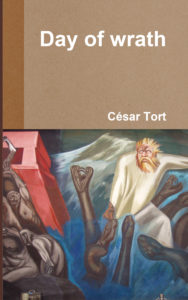As I have watched more documentaries about Jeffrey Dahmer, I have continued to think about what I wrote about this serial killer at the end of last month and the beginning of this month.
Even in the recent Netflix miniseries, there is a moment when detectives ask the arrested Dahmer if his irresistible compulsion to possess body remains of his victims had to do with an unconscious desire to control males. Dahmer replied, ‘Yes’, and added that everyone wanted to tell him what to do, and he mentioned his dad. Dahmer also said that by his horrible actions he wanted others to ‘see his movie’, i.e. what he had suffered. The unspoken implication is that it was revenge in the form of transference onto substitute objects, in that it was finally Dahmer who had the power.
In my September post, I said that Dahmer’s behaviour reminded me of the behaviour of Mesoamerican Amerindians before the Spanish conquest. I don’t know how many of my visitors have read my book Day of Wrath, but there I call Mesoamerican civilisation a civilisation of serial killers. Today, while reviewing an article from another of my books, On Exterminationism, I came across this passage:
Tiesler and Cucina let us know that modern Mayanists are using, in addition to Spanish chronicles and iconographic evidence from pre-Columbian art, the science of taphonomy (skeletal analysis) as tangible evidence of human sacrifice in Mayan civilisation.
On pages 199-200 [of the academic book pictured left] the authors mention the techniques the Maya used in their practices, now corroborated by taphonomy: the victim could have been shot with arrows or stoned, his throat or neck could have been cut or broken, his heart could have been extracted through the diaphragm or thorax; he could have suffered multiple and fatal lacerations, or have been cremated, disembowelled or flayed or dismembered. The bodily remains may have been ingested, used as trophies or in the manufacture of percussion instruments. The authors deduce this from direct, physical evidence from the skeletons studied (or other remains) and also mention a form of sacrifice I hadn’t heard of: the offering of human faces in the context of the influence on the Maya of the Xipe-Totec deity, ‘Our Lord the Flayed’, who was widely worshipped in northern, central Mexico.
As bizarre as it may seem, the psychoclass to which Dahmer belonged is virtually identical to the psychoclass of the ancient inhabitants of the civilisations of Mesoamerica. There were millions of Dahmers in Mesoamerica back then! (presently central Mexico, Belize, Guatemala, El Salvador, Honduras, Nicaragua and northern Costa Rica). In other words, the way to decipher minds like Dahmer’s is to be found in psychohistory, or more specifically, in the appropriation I made in Day of Wrath of the ideas of Lloyd deMause, who died a couple of years ago.







